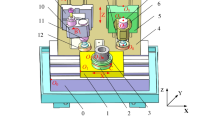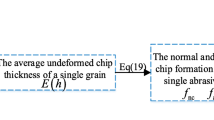Abstract
Machining accuracy is an important index for evaluating the performance of machine tools. To improve the machining accuracy and efficiency of an internal thread grinding machine and reduce the cost, this paper carries out a forward design of the tolerance of the tool motion axis based on the required precision of the workpiece. Using the parameters of a nut raceway, a calculation model of a sand profile under ideal conditions is established under the principle of spiral surface machining and gear meshing. The tolerance criteria are used to evaluate the machining accuracy through multi-body system theory, Monte Carlo simulation, and least squares fitting. Global sensitivity analysis based on variance is used to identify the key factors influencing error. Finally, statistical analysis is completed with the Monte Carlo method to obtain the reliability of machining accuracy. The geometric design is optimized according to reliability to ensure that the tolerance zone meets the required machining accuracy. The feasibility of this method is verified by designing 30 error tolerance zones for an SCS-180 T grinder.
















Similar content being viewed by others
Data availability
The data supporting the conclusions are included in the manuscript.
Code availability
Not applicable.
References
Miyaguchi K, Arai S, Machinery I et al (2013) State of the art ball screw trends for machine tool applications. Journal of SME-Japan 2:13–18
Kopac J, Krajnik P (2006) High-performance grinding—a review. J Mater Process Technol 175:278–284. https://doi.org/10.1016/j.jmatprotec.2005.04.010
Wang J, Guo J (2013) Algorithm for detecting volumetric geometric accuracy of NC machine tool by laser tracker. Chin J Mech Eng 26(1):166–175. https://doi.org/10.3901/CJME.2013.01.166
Li L, Chen Y, Liu B (2008) Precise profile of grinding wheel and interference elimination for high-lead ball-nut. Chin J Mech Eng 44(1):109. https://doi.org/10.3321/j.issn:0577-6686.2008.01.019
Fang DF (2009) Modeling and simulation of large pitch ball screw nut formation grinding[D]. Shanghai Jiao Tong University
Li G, Li X, Liu F et al (2011) Method of profile optimization of a form grinding wheel for grinding with additional radial motion of topologically modified gear. Chin J Mech Eng 47(11):155–162. https://doi.org/10.3901/JME.2011.11.155
Guo S, Yang J, Qiao G et al (2022) Assembly deviation modelling to predict and trace the geometric accuracy of the precision motion system of a CNC machine tool. Mech Mach Theory 169:104687. https://doi.org/10.1016/j.mechmachtheory.2021.104687
Wu H, Zheng H, Li X et al (2020) A geometric accuracy analysis and tolerance robust design approach for a vertical machining center based on the reliability theory. Measurement 161:107809. https://doi.org/10.1016/j.measurement.2020.107809
Zhang Z, Cai L, Cheng Q et al (2019) A geometric error budget method to improve machining accuracy reliability of multi-axis machine tools. J Intell Manuf 30(2):495–519. https://doi.org/10.1007/s10845-016-1260-8
Tang K, Hong R, Fang C et al (2018) Geometric error modeling of grinding dressing system based on multibody theory. Modular Machine Tool & Automatic Manufacturing Technique 1:26–29. https://doi.org/10.13462/j.cnki.mmtamt.2018.01.007
He K (2013) Geometric error modeling and compensation study of CNC gear grinding machine based on the kinematics of multi-body system. Chongqing University. http://dx.chinadoi.cn/10.7666/d.D426616
Jinhua SHEN (2008) Key technique and application in error compensation for CNC machine tools. Shanghai Jiao Tong University, Shanghai
Shangwen CAI, Huifen WANG, Tingyu LIU (2016) Assembly precision prediction and adjustment method based on error propagation model. Mach Build Autom 6:6–10
Wang T, Wu C, Liu H et al (2019) Configuration design and accuracy analysis of special grinding machine for thin-walled small concave surfaces. Precis Eng 56:293–302. https://doi.org/10.1016/j.precisioneng.2018.12.009
Zhang Y, Ji S, Zhao J et al (2016) Tolerance analysis and allocation of special machine tool for manufacturing globoidal cams. Int J Adv Manuf Technol 87(5):1597–1607. https://doi.org/10.1007/s00170-016-8558-8
Chen G, Sun Y, Lu L et al (2016) A new static accuracy design method for ultra-precision machine tool based on global optimisation and error sensitivity analysis. Int J Nanomanuf 12(2):167–180. https://doi.org/10.1504/ijnm.2016.077062
Cheng Q, Zhao H, Zhao Y et al (2018) Machining accuracy reliability analysis of multi-axis machine tool based on Monte Carlo simulation. J Intell Manuf 29(1):191–209. https://doi.org/10.1007/s10845-015-1101-1
Liu Y, Guo J, Li B et al (2019) Sensitivity analysis and tolerance design for precision machine tool. Chin J Mech Eng 55(17):145–152. https://doi.org/10.3901/JME.2019.17.145
Kim K, Kim MK (1991) Volumetric accuracy analysis based on generalized geometric error model in multi-axis machine tools. Mech Mach Theory 26(2):207–219. https://doi.org/10.1016/0094-114x(91)90084-h
Wang H, Li T, Ding X (2021) Tolerance analysis of the volumetric error of heavy-duty machine tool based on interval uncertainty. Int J Adv Manuf Technol 114(7):2185–2199. https://doi.org/10.1007/s00170-021-06941-7
Yu ZM, Liu ZJ, Ai YD et al (2013) Geometric error model and precision distribution based on reliability theory for large CNC gantry guideway grinder. J Mech Eng 49(17):142–151. https://doi.org/10.3901/JME.2013.17.142
Yuan GX, Wang P (2008) Monte Carlo simulation and its application in tolerance design. J Tianjin University of Sci Technol 23(2):60–64. https://doi.org/10.13364/j.issn.1672-6510.2008.02.007
Naess A, Leira BJ, Batsevych O (2009) System reliability analysis by enhanced Monte Carlo simulation. Struct Saf 31(5):349–355. https://doi.org/10.1016/j.strusafe.2009.02.004
Fu G, Rao Y, Xie Y et al (2020) Error sensitivity analysis of motion axis for five-axis CNC machine tools with geometric error contribution. China Mech Eng 31(13):1518. https://doi.org/10.3969/j.issn.1004-132X.2020.13.002
Tang Y, Fan J, Chen D et al (2017) Tracing method for key geometric errors of a machine tool based on Monte Carlo simulation. JB Univ Technol 43:1619–1628. https://doi.org/10.11936/bjutxb2016120032
Fan J, Yun S, Tang Y et al (2017) Research on global sensitivity analysis method of the error factors of the five coordinate machine tool. Manufact Technol Mach Tool 08:70–75. https://doi.org/10.19287/j.cnki.1005-2402.2017.08.017
Fan J, Wang X, Chen D et al (2013) Error sensitivity analysis of machine tool based on multi-body kinematics theory. High Technol Lett 23(03):318–324. https://doi.org/10.3772/j.issn.1002-0470.2013.03.016
Funding
This work was supported by the National Science and Technology Major Project of China (Grant No. TC210H038-002) and the National Natural Science Foundation of China (Grant No. 51905274).
Author information
Authors and Affiliations
Contributions
All authors contributed to the study conception and design. Material preparation, data collection, and analysis were performed by Qiao Jiang, Yun Zou, Sen Huang, and Qun-Chao Qian. The first draft of the manuscript was written by Qiao Jiang. Chang-Guang Zhou and Yi Ou commented and revised on previous versions of the manuscript. All authors read and approved the final manuscript.”
Corresponding authors
Ethics declarations
Ethics approval
The authors confirm that they have abided by the publication ethics and state that this work is original and has not been used for publication anywhere before.
Consent to participate
The authors are willing to participate in journal promotions and updates.
Consent for publication
We further confirm that all authors have checked the manuscript and have agreed to the publication.
Competing interests
The authors declare no competing interests.
Additional information
Publisher's note
Springer Nature remains neutral with regard to jurisdictional claims in published maps and institutional affiliations.
Rights and permissions
Springer Nature or its licensor (e.g. a society or other partner) holds exclusive rights to this article under a publishing agreement with the author(s) or other rightsholder(s); author self-archiving of the accepted manuscript version of this article is solely governed by the terms of such publishing agreement and applicable law.
About this article
Cite this article
Jiang, Q., Ou, Y., Zou, Y. et al. Analysis and optimization of tolerance design for an internal thread grinder. Int J Adv Manuf Technol 125, 5369–5383 (2023). https://doi.org/10.1007/s00170-023-11036-6
Received:
Accepted:
Published:
Issue Date:
DOI: https://doi.org/10.1007/s00170-023-11036-6




